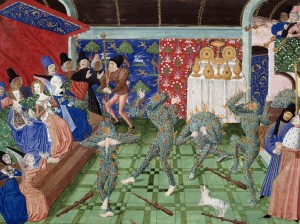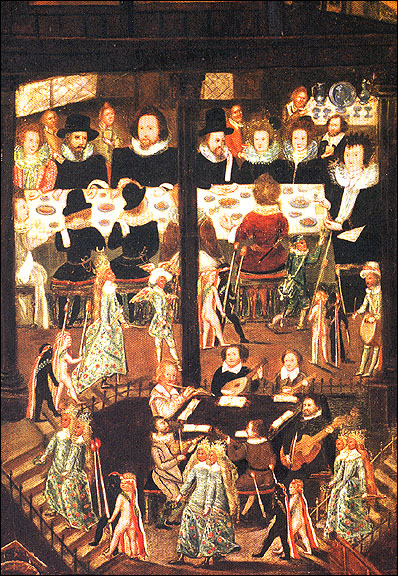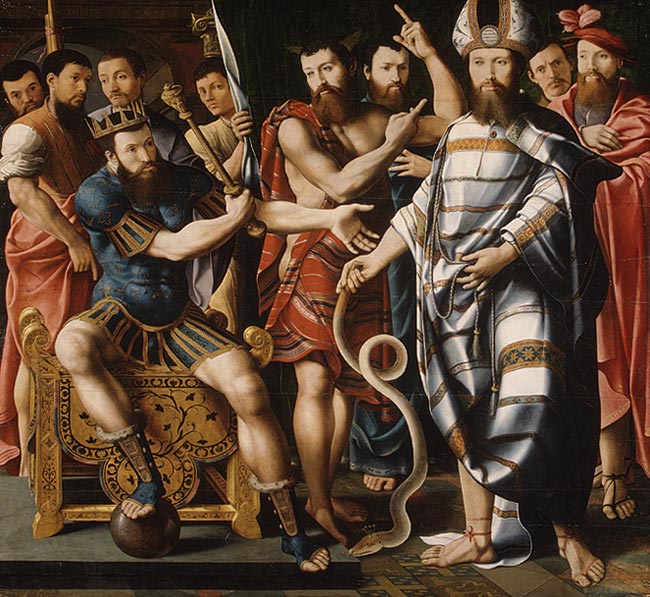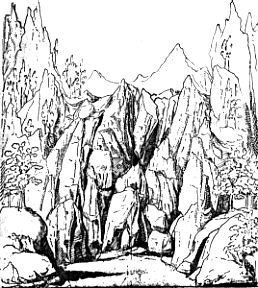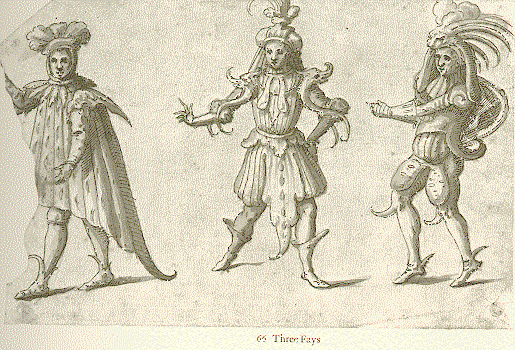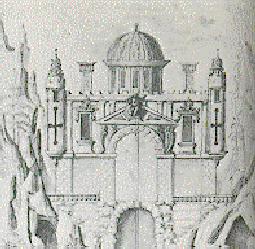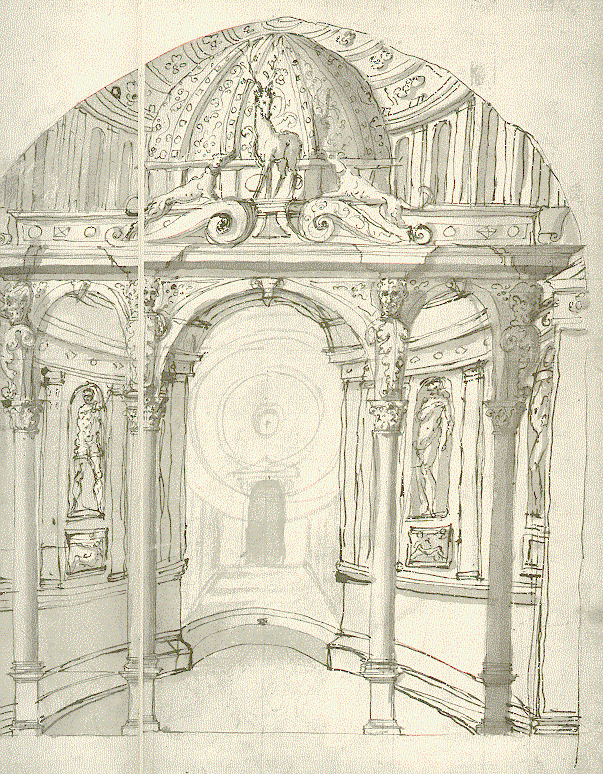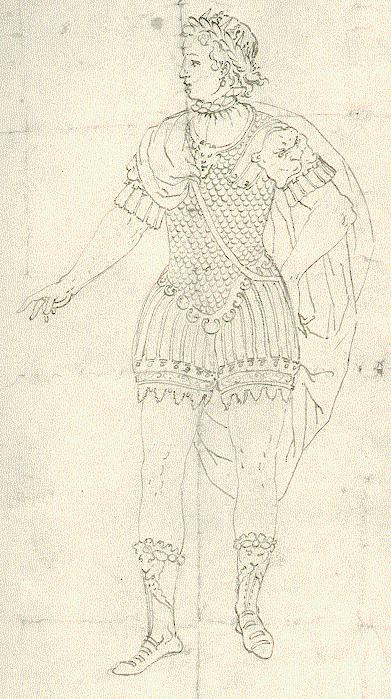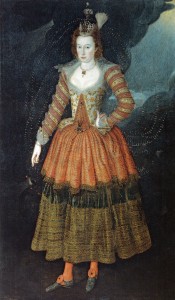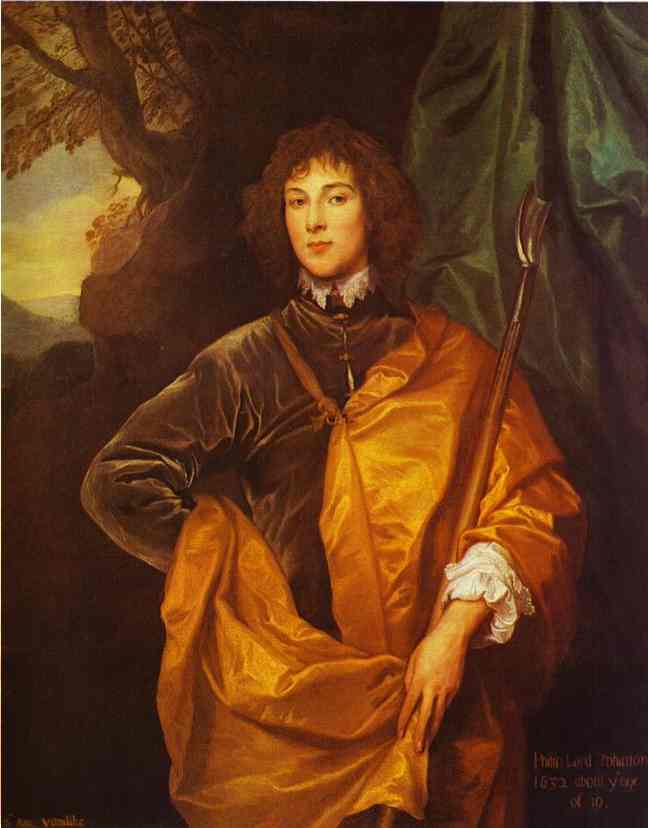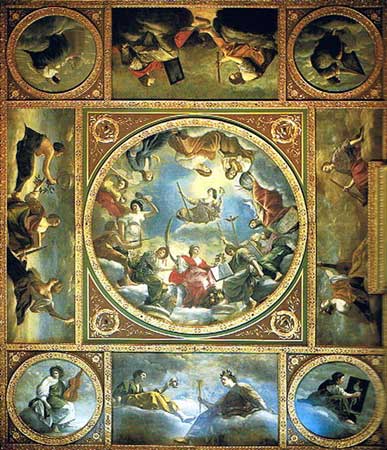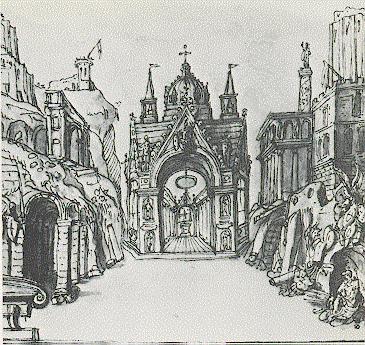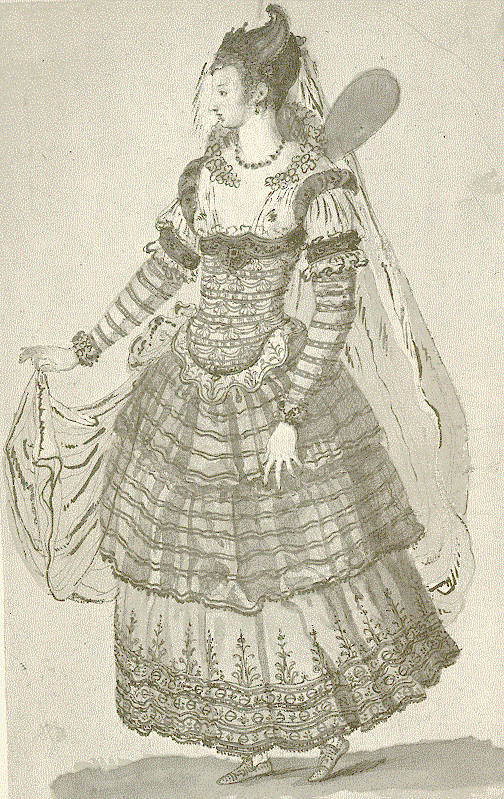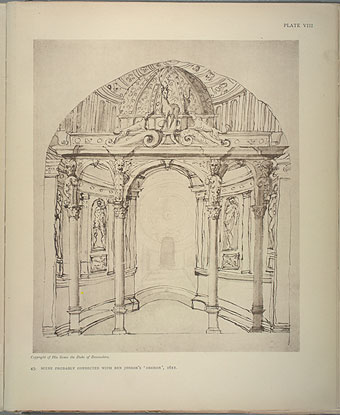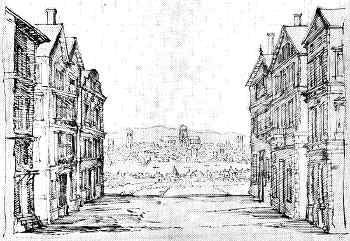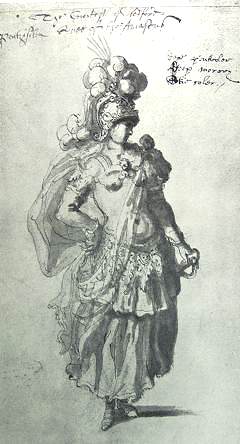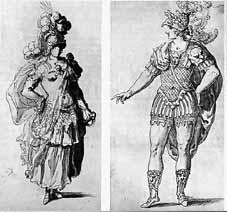Bal de Ascent (Dance of the Flames) from 15th century France shows men dressed as wild men using paper. Their costumes have accidentally caught fire and one was seriously injured although the King was not injured. As a result they banned torches as one courtier had held a torch near one of the dancers to see if it was his friend. It is taken from an illuminated manuscript the Chronicles of France. We see there is a long tradition of getting dressed up and dancing at court.
Sir Henry Unton, 1596, NPG, the year he died, shows his entire life from birth to death. It shows an entertainment in his home with musicians surrounded by figures in extraordinary costumes – Mercury (with the wings), Diana (with bow and arrow and a crescent moon) and pygmies. This was during the reign of Elizabeth and shows a typical Tudor court entertainment with learned allusions.
Accession Day tilt. A drawing from France, the Bayon Magnificancies, 1565, Catherine d’Medici. Showing a whale hunt that lasted thirty minutes. The paper mache whale in the centre look like a fish, there is Neptune and shepherds and shepherdesses dancing. It was a huge outdoor water festival. (See Festivals in Valois France). So all of Europe dressed and danced.
Moses and Aaron before Pharaoh: An Allegory of the Dinteville Family, 1537. For example, a knight in the French court (actually the figure on the left in Holbein’s Ambassadors, Jean de Dinteville ) dressed in quasi-classical garb.
There was an Italian tradition, particularly a Florentine tradition, called the intermezzi. These were entertainments designed to fill in the gap between plays. The key series was in 1589 when the Grand Duke got married. They were trying to recreate a Roman theatre with classical allegory in the form of an entertainment. Bernado Buontalenti was the architect engineer of these displays.
A 1600 Florentine drawing shows a mountain rising from a stage, at the top is Pegasus with Apollo and the Muses below and Poetry below them. Clouds float in with people in them and they have trees that sprout leaves. Light boxes were used containing multiple candles made brighter with mirrors and the theatres were not darkened as much as ours. This event was publicized across Europe and news came back to Henry, Prince of Wales. His friend John Harrington was in Florence and wrote back describing them.
The intermezzi increased the scale and the engineering (trap doors, revolving stages) and it was these the Stuart court wanted to emulate.
Ben Johnson and Inigo Jones were the great double act although they eventually fell out.
Caroline masques in England had a stage with a proscenium arch (first developed in the 16thC in Florence and picked up by Jones). The stage tilts at an angle and it has slots in the sides for scenery. In 1635 Inigo Jones a country scene for The Temple of Love. 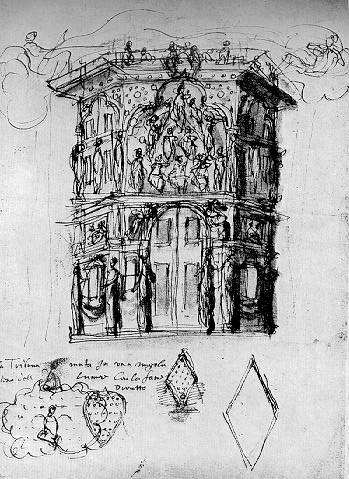
Jones, House of Fame, set drawing
1609 Jones, The Masque of Queens for Anne of Denmark – a machine with a round arch doorway and a revolving section on top with seats. The machine was called machina versitilis.
Anne of Denmark was the prime mover to create these spectacular masques. She loved dancing and was the leading dancer. She singled out Ben Johnson but the ideas were unfortunately hers so they were all a bit thin. All the music and choreography has been lost, in fact the scenery was pulled down and destroyed as soon as the masque was over.
They were modelled on the French ballet do corps where the dancers formed a complex pattern. James I never ever took part.
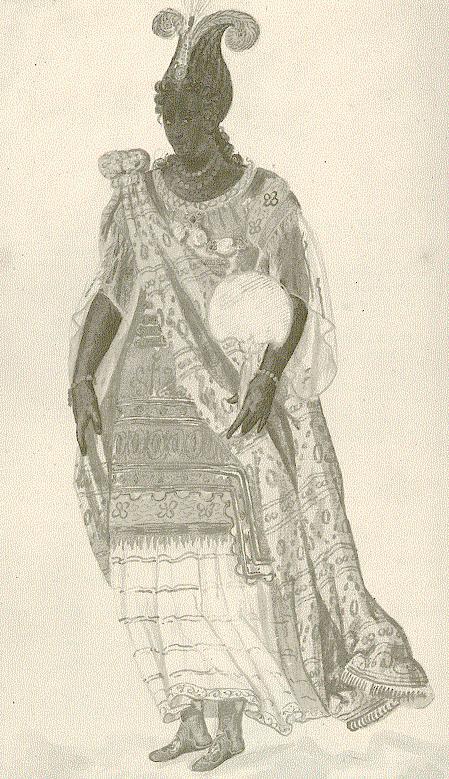
Jones, Masque of Blackness, 1605
1605, 12th Night, the Masque of Blackness was the first. Anne of Denmark had the idea she wanted to black-up herself so they became Ethiopians who lived near the Niger. Note the sketches are very free flowing compared to the rigid painting. Masques were all based on the idea of finding ways of praising the King. The idea of this first masque was that the ladies must find a kingdom ending with “tania” where they will be turned white by the sun and so be made beautiful (masques were not politically correct!). They find Britannia ruled by the Sun – James I – who will bleach them white. Britannia is the empire of England and Scotland and Ireland created by James I (Wales is not mentioned as a separate country as it had no separate court and the laws were the same as England). The symbolic “Egyptian hieroglyphs” were invented by Jones.
A masque would go on till 4.00am in the morning but the text of the masque would only last about an hour so most of the time was taken up with dancing, that is what they were really there for.
The opening scene of Oberon, The Fairy Prince, shows trees and rocks and moonlight. 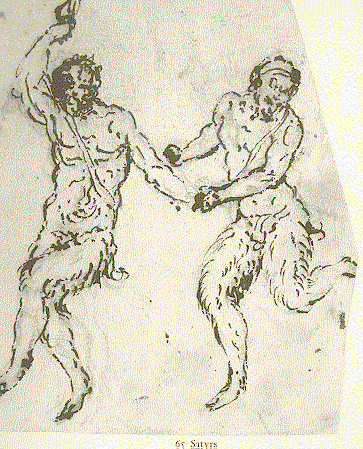
Jones, Satyrs, Oberon, 1611
Jones, Three Fays, Oberon, 1611. A mythical land inhabited by satyrs. The rocks open and inside is:
Jones, Oberon’s Palace, Oberon, 1611. Oberon’s Fairy Palace (in a whole range of styles). Light behind it makes it transparent and you can see:
Jones, Oberon’s Palace, 1611 inside the Palace. At the back is a bright light. Dashing costumes in quasi-Roman style with shorts and boots, cloak and helmet:
Oberon, 1611, Prince Henry himself dressed as Oberon, The Fairy King. 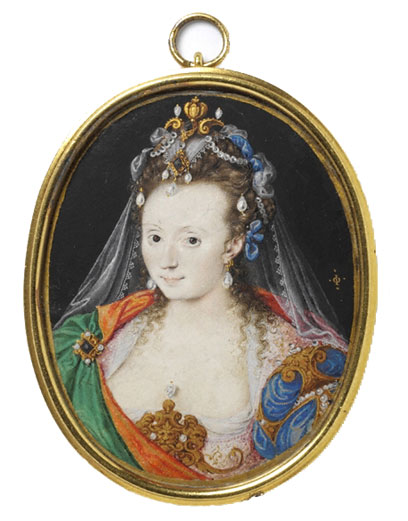
Isaac Oliver (1560-1617), Portrait of an Unknown Woman, about 1609 (V&A miniature), in a masque costume, probably for the Masque of the Queens (2nd February 1609). People often had their portraits painted on masque costume (V&A, Rijksmuseum, 1610) indicating the cost and importance attached to them. Imagine the effect on Puritans of women, including Queen Henrietta Maria, appearing with bare breasts. 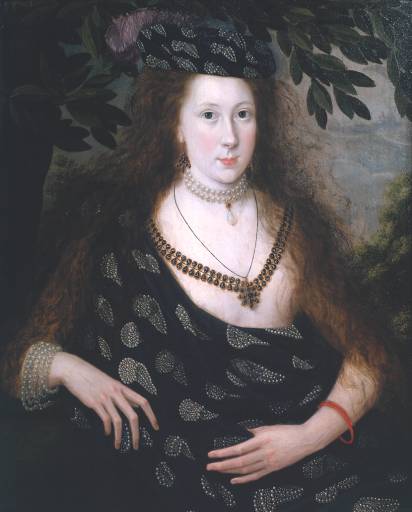
Robert Peake, Lady Elizabeth Pope, c. 1615, the pearls are sewn into the black costume to look like feathers. She is also exposing her breast although the significance of this is not known.
John de Critz, Unknown Lady, 1606, dressed as a power of Juno, full-size, full-length. 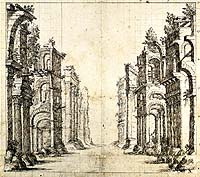
Drawing by Inigo Jones for Scene I of the masque Coelum Britannicum performed at the Banqueting House on Shrove Tuesday night, 18 February 1634. Sir Henry Herbert remarked ‘It was the noblest masque of my time to this day, the best poetrye, best scenes, and the best habitts’.
The stage set for Coelum Britannicum is Roman ruins (possibly classical British ruins), Inigo Jones. In fact all the designs of the period were Inigo Jones. His early rival Constantino de Servio put on some masques but he was over ambitious or incompetent and they were seen as disasters and a waste of the patrons money. The cloud juddered, the pulleys screeched so loud the music could not be heard and then one side of the cloud dropped and the people had to hang on to stop themselves falling off. After him no one else had the invention or the knowledge so Jones had a monopoly until 1640.
The ruin miraculously changes to a Renaissance garden where man tames nature rather than nature overcoming man. The garden design itself would have been new and exciting.
Did the spectators understand the perspective? The following quote 5 below which suggests that at the side they just saw the shutters (wings) sticking out. These scenes are the first landscapes in England (apart from small scenes in the backgrounds of portraits). They were known as landskip (often in italics as it was a Dutch word) and it often had to be explained, as in quote 5.
The scena ductalis, the side wings and back shutter, were in grooves and could be pushed in and out. The number of scene changes was only limited by the number of grooves that could be fitted onto the stage. The scene is described in quote 1 below. It was believed that Brutus of Troy came to Britain to found a classical society. James I probably believed it as well.
The anti-masque (later ante-masque) showed a scene of disharmony, such as satyrs doing a wild dance. The anti-masquers are paid actors not nobility.
[missing]
1640, Salmacida Spolia, design, outdoor scene of tempest and driving rain followed by peace.
[missing]
Cupid’s Palace, Inigo Jones.
[missing]
Dwarf postilion from hell.
Van Dyck, 1632, Philip Lord Wharton (Washington), holds a hoe, his role in a masque such as The Shepherd’s Paradise, 1633.
Sketch of cross-section of stage, audience to left, shows slats at the side, winch at the bottom to pull the cloud machine. There are design for cloud machines that hold one or several people in chairs with the cloud in front of them. The cloud and the seats could be winched up and down.
Caroline Masques
See quote 6 describing Chloridia. This is surprising as poetry was still looked down on as something a gentleman did not do. If you wrote poetry you only published posthumously. Even architecture and sculpture are here listed as the principal attributes of the fame of the realm. Quite amazing.
Painted ceiling from the Queen’s House (Inigo Jones), Greenwich by Orazio Gentileschi assisted by Artemisia. The ceiling at Greenwich is now a reproduction. It shows the liberal arts including architecture.
Gerald van Honthorst , Apollo and Diana, 1628, Hampton Court. The image evokes a masque as they are sitting on a cloud. Buckingham is in the centre with his wife. He married the daughter of Francis Manners, 6th Earl of Rutland, Katherine Manners, later suo jure Baroness de Ros, on May 16, 1620 despite the objections of her father. The goats and bearded man being driven away at the left are like an antimasque. Honthorst went to Italy in 1610 so he brought his own ideas to the painting. The painting is recorded as being in the Banqueting Hall so it is likely it was a gift from Buckingham to Charles.
Masque of Oberon cost over £1,000 and the Masque of Queens cost £3,000. Masques were extremely expensive and were held once after which all the scenery was destroyed. 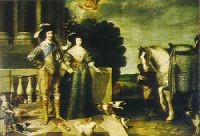
Mytens, Charles I and Henrietta Maria Departing for the Chase, Hampton Court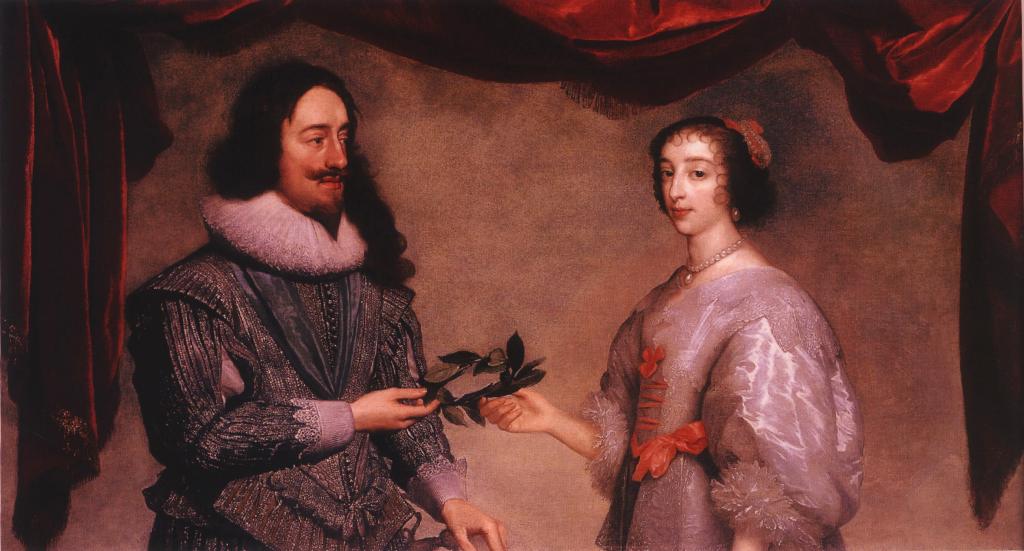
Mytens, Charles and Henrietta, Hampton Court.
See quote 10 below about the “paradise of love.” This was a theme of the masques of Charles I. Love brings together Peace (Charles father James I) and War (Henrietta Maria’s father Henry IV). This was the time of the 11 years of Personal Rule (1629-1640) when Charles refused to call Parliament. His critics called it the years of Personal Tyranny.
See quote 3 below, Heroic Virtue. The divine right to rule as a god on earth through all the virtues. Charles basic mistake that led to his execution is that he actually believed he was appointed by God and did have a divine right to rule as a god on earth who incorporated all the virtues.
The culture of James I was of sexual abandon and this changed completely with Charles who was faithful to his wife. However, the art of the period was at its highest in James reign (the time of Shakespeare). By Charles reign the arts became superficial and vacuous.
The divine right of kings pervades all the masques. In one we see the God’s come to Britain as they want to model heaven on Charles’s court as it is more virtuous than heaven. Extraordinary hyperbole, particularly as Charles believed it.
Coelum Britannicum. Charles as Phylogenies, many people in the clouds descend to earth to a land of classical temples. This is the eve of the Civil War and Charles was still dressing up each day in costume to practice his role. See quote 11. It is clear that Charles believes the people have such an easy peaceful live they so not see how lucky they are and maybe they will come to their senses.
Other Masque Designs
Jones, Prince Henry’s Barriers
Jones, female masquer
Jones, Masque Design
Jones, Britannia Triumphans, 1638
Pentilisia, The Mask of Queens, 1609
Pentesilea, The Mask of Queens, 1609; and Oberon, The Fairy Prince, 1611 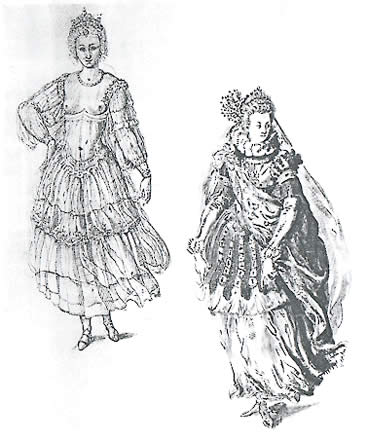
More examples of masque costumes
- Renaissance and Medieval portraits.
- Various portraits 1595-1610
- Various portraits 1610-1621
- Masques at the Banqueting House
Quotes
For the full texts of the masques see S. Orgel & R. Strong (eds), Inigo Jones: The Theatre of the Stuart Court, 2 volumes (1973).
1. Coelum Britannicum (18th February 1634): The Description of the Scene The curtain was watchet [pale blue] and a pale yellow in panes, which flying up on the sudden discovered the scene, representing old arches, old palaces, decayed walls, parts of temples, theatres, basilicas and thermae [hot springs], with confused heaps of broken columns, bases, cornices and statues, lying as underground, and altogether resembling the ruins of some great city of the ancient Romans or civilised Britons. (11 32-37)
2. Coelum Britannicum (18 February 1634): When this anti-masque was past, there began to arise out of the earth the top of a hill, which by little and little grew to be a huge mountain that covered all the scene; the underpart of this was wild and craggy, and above somewhat more pleasant and flourishing; about the middle part of this mountain were seated the three kingdoms of England, Scotland and Ireland, all richly attired in regal habits appropriated to the several nations, with crowns on their heads, and each of them bearing the ancient arms of the kingdoms they represented. At a distance above sat a young man in a white embroidered robe, upon his fair hair an olive garland, with wings at his shoulders, and holding in his hand a cornucopia filled with corn and fruits, representing the genius of these kingdoms. (11 887-898)
3. Tempe Restored (14th February 1632): In Heroic Virtue is figured the King’s majesty, who therein transcends as far common men as they are above beasts, he truly being the prototype to all the kingdoms under his monarchy of religion, justice, and all the virtues joined together.
4. Lucy Hutchinson remembering the change in atmosphere at court following the accession of Charles I (Memoirs of the Life of Colonel Hutchinson (London, 1906), p.69): The face of the court was much changed in the change of the King, for King Charles was temperate, chaste and serious; so that the fools and bawds, mimics and catamites, of the former court, grew out of fashion, and the nobility and courtiers, who did not quite abandon their debaucheries, yet so reverenced the king as to retire into corners to practice them. [Note: ‘catamite’ means ‘a boy kept for unnatural purposes’.]
5. Anthony a Wood, reporting comments made to him about a production put on in 1636 (quoted in Orgel & Strong, p.l2): It was acted on a goodly stage reaching from the upper end of the Hall almost to the hearth place, and had on it three or four openings on each side thereof, and partitions between them, much resembling the desks or studies in a Library, out of which the Actors issued forth. The said partitions they could draw in and out at their pleasure upon a sudden, and thrust out new in their places according to the nature of the Screen, whereupon were represented Churches, Dwellinghouses, Palaces, etc. which for its variety bred very great admiration.
6. Chioridia (1631): Here out of the Earth, ariseth a Hill, and on top of it, a globe, on which Fame is seene standing, with her trumpet in her hand; and on the Hill, are seated four Persons, presenting Poesie, History, Architecture, and Sculpture: who together with the Nymphs, Floods, and Fountaynes, make a fhll Quire; a which, Fame begins to mount, and moving her wings, flyeth, singing, up to Heaven. (11 275-281)
7. Ben Jonson in his preface to the published account of Hymenaei, which was a masque to mark the marriage of the Earl of Essex and Frances Howard, 5th January 1606: This it is hath made the most royal princes and greatest persons, who are commonly the persecutors of these actions. . . studious of riches and magnificence in the outward celebration or show, which rightly becomes them.
8. James Howell in a letter of 1635 (Orgel & Strong U, p.183): The Court affords little news at present, but that there is a Love called Platonic, which much sways there of late: It is a love abstracted from all corporeal gross impressions and sensual appetite.
9. Tempe Restored (14th February 1632): So that corporeal beauty, consisting in symmetry, colour, and certain unexpressable graces, shining in the Queen’s majesty, may draw us to the contemplation of the beauty of the soul, unto which it hath analogy.
10. The Triumph of Peace (1634): To you great King and Queen, whose smile Doth scatter blessings through this isle, To make it best And wonder of the rest, We pay the duty of our birth, Proud to wait upon that earth Whereon you move, Which shall be named, And by your chaste embraces famed, The paradise of love. (11 608-617)
11. Salmacida Spolia, 1640 (The last great Stuart court masque before the outbreak of Civil War): Concord Why should I hasten hither, since the good I bring to men is slowly understood? Genius I know it is the people’s vice To lay too mean, too cheap a price On every blessing they possess. Th’ enjoying makes them think it less. Concord 11 then, the need of what is good Doth make it loved or understood, Or ’tis by absence better known, I shall be valued when I’m gone. Genius Yet stay, 0 stay Concord I will! And much I grieve that, though the best Of kingly science harbours in his breast, Yet ’tis his fate to rule in adverse times When wisdom must awhile give place to crimes. Both 0 who but he could thus endure To live and govern in a sullen age, When it is harder far to cure The people’s folly than resist their rage? (11 170-199)

